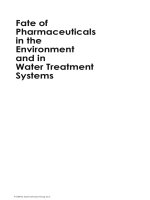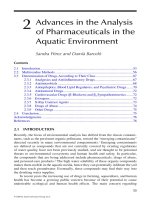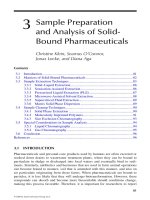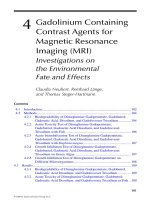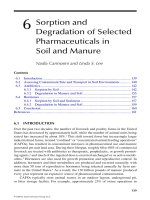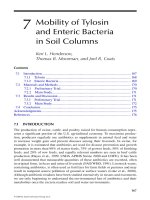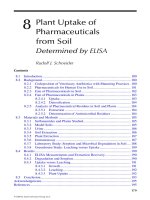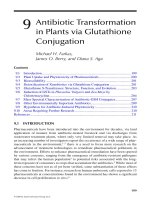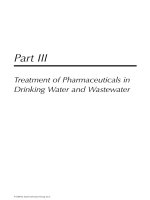Fate of Pharmaceuticals in the Environment and in Water Treatment Systems - Chapter 8 potx
Bạn đang xem bản rút gọn của tài liệu. Xem và tải ngay bản đầy đủ của tài liệu tại đây (407.81 KB, 20 trang )
179
8
Plant Uptake of
Pharmaceuticals
from Soil
Determined by ELISA
Rudolf J. Schneider
Contents
8.1 Introduction 180
8.2 Background 180
8.2.1 CodepositionofVeterinaryAntibioticswithManuringPractices .180
8.2.2 Pharmaceuticals for Human Use in Soil 181
8.2.3 Fate of Pharmaceuticals in Soil 182
8.2.4 Fate of Pha r mac euticals i n Plants 183
8.2.4.1 Uptake 183
8.2.4.2 Detoxication 184
8.2.5 Analysis of Pharmaceutical Residues in Soil and Plants 184
8.2.5.1 Extraction 184
8.2.5.2 Determination of Antimicrobial Residues 184
8.3 Materials and Methods 185
8.3.1 Sulfonamides and Plants Studied 185
8.3.2 Model Soils 185
8.3.3 Urine 186
8.3.4 Soil Extraction 186
8.3.5 Plant Extraction 187
8.3.6 Immunoassay 187
8.3.7 Laboratory Study: Sorption and Microbial Degradation in Soil 188
8.3.8 Greenhouse Study: Leaching versus Uptake 189
8.4 Results 190
8.4.1 ELISA Measurements and Extraction Recovery 190
8.4.2 Degradation and Sorption 190
8.4.3 Uptake versus Leachi ng 191
8.4.3.1 Growth 191
8.4.3.2 Leaching 192
8.4.3.3 Plant Uptake 192
8.5 Conclusion 193
Ack nowledgments 195
References 195
© 2008 by Taylor & Francis Group, LLC
180 Fate of Pharmaceuticals in the Environment and in Water Treatment Systems
8.1 INTRODUCTION
Plants taketheirnutrientsfromtheairandairmoisture(fog,dew,andrainfall),and
are able t
otakeupdissolvedcompoundsfromsoilwatertoliveandgrow.Many
plants live in symbiosis with soil fungi (mycorrhiza), which themselves are able to
uptake and deliver specic solutes to their host. Unfortunately, in the process of tak-
i
n
gupessentialplantnutrientsandenergysources,plantsalsotakeupheavymetals,
pesticides, and other bioavailable pollutants that are undesirable for human consump-
t
i
on.Forexample,ithasbeenrecognizedthattherearemechanismsthatleadtothe
uptakeofinsecticidessuchasDDTinnontargetedplants.Havinglearnedthelessons
onthepotentialofpassiveuptakeofxenobioticsintothecrops,thereisconcernthat
plantswouldalsotakeuppharmacologicallyactivecompoundsfromcontaminated
soil,thusaccumulatingunwantedpharmaceuticalsinediblepartsofcrops.
Knowledge on nutrient uptake, such as that of nitrate, phosphate, sulfate, ammo
-
n
i
um, and potassium, is well established and is the basis of understanding and man-
agi
ng plant production.Sim i
larly, knowledge on the uptake of soil-applied pesticides
is also huge because it is essential for designing and assessing the efcacy of crop
protectionagents.However,studiesonplantuptakeofpharmaceuticalsarelimited
todate.Therefore,thispaperdescribesresultsofexperimentsthatstudyplantuptake
of two sulfonamide antimicrobials: sulfamethazine and sulfamethoxazole—the rst
beingaveterinarydrugandthelatterusedinhumantherapy.Modelexperiments
examining degradation, leaching, and uptake were performed. Concentrations in
water, soil, and plants were analyzed using two selective enzyme immunoassays
(ELISA).
8.2 BACKGROUND
8.2.1 C
ODEPOSITION OF VETERINARY ANTIBIOTICS WITH MANURING PRACTICES
Millions of chemical compounds are present in the atmosphere, mostly of natural ori-
gin,butthousandsofthemareofxenobioticnature.Bywetanddrydeposition,often
adsorbed on aerosol particles and traveling over large distances, they are deposited
onto the soil surface. For most plants the top soil layer is the most important inter
-
fa
cewiththeirenvironment,providingsupportandprotectionoftherootsand,atthe
sametime,water,nutrients,andsomeotherlow-molecularweightcompounds.
Thereareotherintentionaldepositionsofchemicalsubstancesthataretradition
-
al
ly carried out, especially the application of fertilizer or pesticides on agricultural
elds.Theapplicationsofplantresiduessuchasstrawandmulchandofnutrient-rich
residuesfromlivestockbreedingasdungandliquidmanureareinmanyregionsof
the world widely used to fertilize the soil in order to ll up the soil’s nutrient res
-
ervoirs.Inthe1980sresearchersbecameawarethatthispracticecouldleadtothe
inputofpharmaceuticalcompoundsintosoilsusedforplantproduction.
Afteroralorparenteraladministrationofpharmaceuticals,suchasveterinary
antibiotics or growth promoters, these compounds may undergo natural metabolism,
inwhichtheyaredegradedtoamajororminordegree,dependingontheirchemical
properties. Pharmaceuticals can be ranked among the more persistent substances,
© 2008 by Taylor & Francis Group, LLC
Plant Uptake of Pharmaceuticals from Soil 181
sincetheyhavebeendevelopedtoremainactiveinthebodyforsometimewithout
deactivation or degradation.
1
Many antimicrobial substances are excreted unchanged,
with a share from 50 to 70% for penicillin G and 70 to 90% for tetracyclines.
2
Thera-
peutic doses of tetracyclines (ca. 40 mg kg
–1
d
–1
) can result in manure concentrations
of200mgkg
–1
during treatment.
3
The stability of some groups of pharmaceuticals in manure, especially antimi-
crobials,hasbeenthetopicofmanystudies.
4–7
Itwasfoundthatduringstorageofthe
manure,someresiduesremainstableforalongperiodoftime.Meyeretal.
8
found
tetracyclines in concentrations between 5 and 870 µg L
–1
in all of 13 studied swine
manure storage tanks. Other studies found concentrations of tetracycline up to 66 g
m
–3
inswinemanurewithadegradationoflessthan5%after7weeks.
5
Sulfonamides
arestableinmanureuntilapplication,too,
9
especially with nonoptimal conditions
(e.g., cold weather, anaerobic conditions),
10,11
buthighertemperaturesandadapta-
tion of the microorganisms enhance degradation.
12
Metabolites (e.g., the glucuro-
nide of chloramphenicol or N-4-acetylsulfamethazine) can be cleaved in manure and
thus transformed back to the active ingredients, such that their concentrations may
increase with time.
13
As manure is usually collected and stored for several weeks,
only compounds that resist degradation for this period will enter the soil compart-
me
ntwhenmanureisappliedtosoil(Figure 8.1).
8.2.2 PHARMACEUTICALS FOR HUMAN USE IN SOIL
Wastewater of human origin may also contain residues of pharmaceuticals, espe-
ciallywhentheycomefromhospitals,whichobviouslyhavealargerconsumptionin
pharmaceuticals such as antibiotics. Some substances are excreted in relatively high
amounts, while on the other hand there are compounds like sulfamethoxazole that
aremetabolizedupto85%;hence,only15%oftheoriginalsubstancethatcanbe
foundinurineorfeces
2
will enter wastewater. The fate of pharmaceuticals during
wastewatertreatmentisdiscussedinPartIIIofthisbook.
Wastewaterinurbanizedregionsisusuallytransportedviasubterraneansewer
systems to wastewater treatment plants. It should be noted that less polar pharma
-
ceuticals may adsorb to sewage sludge during wastewater treatment. In countries
Application to Agricultural Fields
Pharmaceuticals (vet./hum.)
Animal Manure Human Urine
Storage
Wastewater Treatment
with Sorption of
Compounds to Sewage Sludge
Urine
Separation
and
Ecological
Sanitation
FIGURE 8.1 Pathways of pharmaceuticals to agricultural soils.
© 2008 by Taylor & Francis Group, LLC
182 Fate of Pharmaceuticals in the Environment and in Water Treatment Systems
whereagriculturaluseofsewagesludgeisstillanoption,thismayleadtoaninput
of these compounds into the soil environment (see Figure 8.1). Some c
ountries, some
ofwhichhavescatteredsettlementinruralareasorinalpineregions,startedopting
for complementing “decentralized wastewater treatment” pursuing “ecological sani-
tation” (see also: Ecological
sanitationisbasedonsourceseparationoffecesfromurine(e.g.,in“no-mix”toilets
andwaterlessurinals)sothataftersomebasictreatmenttoeliminatefecalpathogens
(often simple storage is sufcient) the solid components can be composted together
with organic garbage and the urine used separately. These low-cost and low-mainte-
na
ncesystemsareespeciallyinterestingfordevelopingcountrieswheremorethan
80%ofsewageisdischargedwithoutanytreatment,wastingthenutrientsnitrogen
(nitrate, ammonia), phosphate, and potassium, which can be used in sustainable agri-
cu
lturelikeorganicfarming,closingnutrientcycleswhileprotectingsurfacewater
and groundwater from eutrophication.
It is clear that human urine may contain residues of pharmaceuticals and that a
sanitation concept including urine recycling will lead to an input of these compounds
intothetopsoillayerofagriculturaleldsorwilllimittheusabilityoftheurine.
The experiments described in this contribution were carried out with urine collected
inaurinetankfromasmallclosed-loopsanitationproject(WaterMillMuseum
“Lambertsmühle,” Burscheid, Germany) where acceptance, efciency, storage, and
fertilization studies have been undertaken.
14
8.2.3 FATE OF PHARMACEUTICALS IN SOIL
Reviews on the fate of veterinary antibiotics,
15
uoroquinolones,
16
and sulfonamides
17
appeared recently. It is also discussed in Chapter 5 of this book. Compounds that
have entered the pedosphere disappear with time. Dissipation can be subdivided in
the concurrent processes sorption/binding, degradation, leaching, and plant uptake.
The share of these processes depends predominantly on the properties of the com-
po
undsandthesoilsandtherelativetimescaleofeachprocess.
Physicochemical parameters that are important in predicting the fate of con-
ta
minantsinsoilhavebeencollatedforantibioticsinthereviewarticlesbyTolls
18
and Thiele-Bruhn.
19
Chapter 6 in this book also provides an overview of sorption and
degradation of selected pharmaceuticals in soil and manure. In all these reviews it is
apparent that the sorption of pharmaceuticals in soil can vary widely. For instance,
partition coefcients between soil and water (K
d
)forsulfonamidesindiversesoils
range from 0.9 to 10, suggesting low sorption, while tetracyclines show values
between 417 and 1026, indicating that tetracyclines are strongly adsorbed. Strepto-
my
cin adsorbs preferentially to the clay fraction in soil.
11
Thisalsoholdstrueforthe
uoroquinolones.
20–22
Adsorption of sulfonamide antimicrobials is highly dependent
on soil pH and ionic strength.
23
Sorption of tetracyclines to clays showed differences
for K- and Ca-saturation due to cation bridging, with humic substances being an
additional factor.
24
Kinetics also have to be taken into account.
25
With some com-
pounds(e.g.,virginiamycin)soilmetabolitesformthathavetobeaccountedfor.
26
© 2008 by Taylor & Francis Group, LLC
Plant Uptake of Pharmaceuticals from Soil 183
Nondegraded residues in the top soil layers can be dislocated by surface run-
offorinterowandpreferentialow.
27
Usuallythegoverningprocesswithpolar
compoundsisleaching.Insandysoilstetracyclinescanleachtolowerlevels,buttoa
higherextentthishappenswithsulfonamides,eventuallyevenintogroundwater.
28,29
Sulfamethoxazole is relatively mobile in soil and has been detected in groundwater
(upto0.47µgL
–1
).
8
For another sulfonamide, sulfachlorpyridazine, sorption coef-
cientsinsoilhavebeendeterminedthatimplypreferentialleachingwiththedrain-
age
water.
30
Thesulfonamidesulfapyridinehasbeenfoundtoadsorbstrongerin
moist soils than in dry ones.
31
Inalysimeterstudyithasbeenshownthatabreak-
throughofsulfadiazinethroughsoilcolumnswasonlyslightlyretardedagainsta
water tracer.
32
8.2.4 FATE OF PHARMACEUTICALS IN PLANTS
8.2 .4.1 Uptake
There are a number of studies indicating that pharmaceutical residues that are
reversibly adsorbed to soil may be taken up by
plants.
33
Ine arly experiments using
hydroponic culture, as well as in pot experiments with chlortetracycline and oxytet-
ra
cycline,theeffectofstimulatednitrogenuptakeshownbywheatandcornplants
grownonasandyloamdemonstratedtheuptakeandactivityoftheresidueswithin
the plants.
34,35
In a greenhouse experiment, corn took up lasalocid and monensin.
36
In laboratory experiments it has been demonstrated that uptake of sulfadimethoxin
in sorghum, pea, and corn inuence their development and is dependent on bioac
-
cu
mulationofthesespecies;bioaccumulationismorepronouncedforC-4plants
(sorghum and corn) than for C-3 plants (pea, ryegrass).
9
From hydroponic culture
(300 mg L
–1
Sulfadimethoxin) plants incorporated the sulfonamide until nal con-
centrations of 180 to 2000 mg kg
–1
.Rootsofcornandsorghumaccumulatedmuch
more active ingredient than the shoots. Similar results were obtained from rye, car-
ro
t,corn,sorghum,andpeaineldtrials.
37
Enrooxacin was also accumulated in
µg g
–1
amounts.
38
Plantuptakeisgovernedbymanyfactors,andithasbeenstudiedwithmany
compounds other than pharmaceuticals because of its potential for phytoremedia-
tion.
39
Even genotype can be important to assess the uptake of contaminants.
40
Roots
suchascarrotsandpotatotuberscantakeupveryhighamountsofpollutants.
41
Mycorrhizationisalsoanimportantfactorashasbeenshownfortheuptakeofatra-
zine.
42
Even desorption-resistant organic compounds can be taken up into the roots,
to some extent, from sediments, which means that compound properties sometimes
do not modulate uptake and that root sorption may be the dominant mechanism
vs.translocationintheplantfornonpolarcompounds.
43
The class of xenobiotics
whose uptake has been intensively studied is pesticides, especially herbicides that
may affect nontarget plants.
44,45
Uptake of pharmaceuticals may also inuence plant development.
46
It is in
partnotclearifthenegativeeffectsonplantsoriginatefromadirectdamageon
the plant by the ingredients (phytotoxicity) or if the antimicrobial action on soil
microorganisms is responsible for the damage by affecting the plant-microorganism
symbiosis.
47–49
Antibiotics in the soil may inuence plant development indirectly by
© 2008 by Taylor & Francis Group, LLC
184 Fate of Pharmaceuticals in the Environment and in Water Treatment Systems
disruptingsoilcommunities:thedecayinthenumberofsoilbacterialeadstoalack
of feed for soil fauna (protozoa, nematodes, microarthropods) and nally inuences
soil functions: plant residues are decomposed slower, denitrication is slower, and
thereforenutrientsarerecycledmoreslowly.
50
Risk assessments for the uptake of
pharmaceuticals in edible portions of crops suggest that with the allergenic potential
andlong-termeffectsofantibiotics,theriskisnotnegligible.
51,52
8.2.4.2 Detoxification
Plants are not without defense against xenobiotic compounds, which they (passively)
take up. There is a three-step detoxication mechanism that acts on foreign com
-
po
unds, once termed the “green liver.”
53,54
Nucleophilic substances are conjugated to
glutathione, a process intensively studied with herbicides.
55,56
Glutathione conjugates
are the transport forms of many xenobiotics; compartmentation is potentially the
nalpurposeofthisprocess.
57
Meanwhile,thispathwayhasalsobeenfoundforthe
detoxication of chlortetracycline in corn
58
;Chapter9ofthisbookisdedicatedto
that mechanism.
8.2.5 ANALYSIS OF PHARMACEUTICAL RESIDUES IN SOIL AND PLANTS
8.2.5.1 Extraction
Sulfonamides are highly water soluble (sulfamethazine: 1500 mg L
–1
, sulfamethoxa-
zole: 610 mg L
–1
), allowing efcient extraction using methanol or methanol/water
mixtures as extraction solvents. On the other hand, it is well known that methanol
coextractsahugevarietyoforganicsoilconstituents,andthisisalsotrueforplants.
liquid chromatography with tandem mass spectrometry (LC-MS/MS) may therefore
behampered,especiallybygivingrisetosuppressionduringionization,whichleads
to underestimations of the concentrations in the extracts.
Methanol has a relatively low bowling point of ca. 64°C, but with the method
of pressurized uid extraction,
59
whichcanbeperformedwithcommerciallyavail-
able accelerated solvent extraction (ASE) equipment, organic solvents can be used
attemperaturesupto200°Cbyholding,forexample,apressureof20MPainhigh
pressure cells.
60
With polar herbicides extraction times have been reduced dramati-
cally(18hSoxhletversus<22minASE)andareductionofsolventuse(300mL
versus <80 mL) was also achieved.
59
Samples that contain considerable amounts of
water, like plants, can be handled in a better way by addition of diatomaceous earth
to the samples (e.g., Extrelut™, Merck).
60
Aged residues of sulfonamide antibiotics
couldbeexhaustivelyextractedbyamixtureofaqueousbufferandacetonitrileat
elevated temperature.
61
8.2.5.2 Determination of Antimicrobial Residues
Residues of pharmaceuticals in plant and soil samples are usually analyzed by chro-
mat
ographic methods coupled to mass spectrometric (LC/MS) methods.
62
For food
analysis,especiallywithsulfonamidesinmilk,immunoassayshavebeenusedfor
almost two decades (e.g., Märtlbauer et al.
63
). In fact, class specic assays have been
developed for this application.
64,65
For the analysis of pharmaceuticals in plants or
© 2008 by Taylor & Francis Group, LLC
Plant Uptake of Pharmaceuticals from Soil 185
soilsbyimmunoassay,onlyasmallnumberofliteratureexists.Oneexampleisthe
determinationoftetracyclinewithELISAkitsbyAgaandcoworkers
66
and our study
on the determination of sulfamethazine in soil extracts
13
using the antibodies pre-
paredbyFráneketal.
67
8.3 MATERIALS AND METHODS
All chemicals were used at least in analytical grade. Pharmaceutical standards sul-
famethazine (sulfadimidin) and sulfamethoxazole for the construction of calibration
curves were prepared from reference substances obtained from Riedel-de Haën and
were of 99.7% and 99.9% purity, respectively. The expression “ultrapure water” in
thetextreferstowaterdeionizedbyreverseosmosisandsubsequentpassagethrough
aMilli-Q
®
water purication system. Methanol was high performance liquid chro-
matography (HPLC) grade.
8.3.1 SULFONAMIDES AND PLANTS STUDIED
Sulfamethazine (SMZ, in Europe frequently named “sulphadimidine”) and sulfa-
methoxazole (SMX) have been chosen from the sulfonamide antimicrobials because
much data on their properties and behavior exist. The chemical structures of these
compounds are show in Figure 8.2. pK
a
values are 2.4 and 7.4 and 1.8 and 6.0 for
sulfamethazine and sulfamethoxazole, respectively.
61
Sulfamethazine is a frequently
usedveterinaryantibiotic,andinapreviousstudyithasbeendetectedinsoilincon-
ce
ntrationsupto17µgkg
–1
soil.
13
As it is frequently detected in swine manure it can-
notbeexcludedthatthesoilsstudiedhadbeenincontactwiththechemicalbefore.
Sulfamethoxazoleisastandardantibioticagainstcommoncold.Ithasbeenfound
frequently in freshwater monitoring.
68
AsamodelplantforuptakeItalianryegrass
(Lolium multiorum italicum,
type: Turilo), a forage grass plant, was chosen.
8.3.2 MODEL SOILS
Soilsofdifferentcompositionwereselectedforthestudies.Twoofthesoilsorigi-
natedfromthelong-termeldexperimentsattheUniversityofBonn
69
and at Bayer
N
N
CH
3
CH
3
R =
Sulfamethazine (SMZ)
(vet.)
SN
H
O
O
NH
2
R
N
O
CH
3
R =
Sulfamethoxazole (SMX)
(hum.)
FIGURE 8.2 Chemical structures of the compounds studied.
© 2008 by Taylor & Francis Group, LLC
186 Fate of Pharmaceuticals in the Environment and in Water Treatment Systems
Crop Science Corporation facilities at Burscheid. All soils had been taken from the
topsoillayeratleast1yearbeforetheexperiments,airdriedandsievedthrougha
sievewith5-mmporewidth,exceptsoilCwhichwasusedfreshly.Table 8.1 pro-
vides soil data.
8.3.3 URINE
Urine was collected from the model project on ecological sanitation described in
Section8.2.2andwasbetween1and3monthsofage;pHwas9.Urinespikingwas
performedatIWWWaterCenter,Mülheim/Ruhr,Germany.Eightotherpharmaceu-
ticals were present in the spiking solution but were not analyzed in this project. Their
effect on the course of the plant experiment and on the analytical accuracy has been
determined to be negligible in separate experiments (data not shown).
8.3.4 SOIL EXTRACTION
Soilsamples(equivalentto10.0gdrymass)weresubjectedtoASEusinganASE
®
200 Extractor (Dionex). The 11-mL extraction cells were used, with the frits of the
cellheadsprotectedagainstcloggingbyaglassberlterandca.1gofdiatoma-
ceous earth (Isolute
®
HM-N, Part. No. 9800-1000, Separtis) on top of the soil sample.
The extracts were collected in 40-mL collection vials with Teon-lined silicon septa.
Theparametersofextractionwere:preheating10min,heatingofthecell5min,
stationaryextraction8min,pressure140bar,temperature80°C,solventmethanol:
ultrapurewater9:1v/v,rinsingsolventvolume50%ofcellvolume,twoextraction
cycles,purgesolventfromcellwithnitrogen(5.0)for60sec.
After extraction, about 15 to 20 mL of extract were obtained, depending on the
water contents of the soil sample and its pore volume. The extracts were evaporated
to almost dryness in a water bath (30°C) by nitrogen (5.0) from stainless steel nee-
dles. The larger part of methanol evaporated rst and an azeotrope of methanol and
water formed reducing largely evaporation speed. The residue is almost completely
aqueous.Itwasresuspendedin5.00mLofultrapurewaterandtreatedinanultra-
sonicbathfor30sectocompletelydissolvetheactiveingredient.Aportionofthis
TABLE 8.1
Model Soil Characteristics
Soil A B C D
Soil Type Loamy silt Sandy silt Loam Sand
Texture lU sU L S
Sampling Depth 0–30 cm 0–15 cm 0–15 cm 0–30 cm
Status Dry Dry Fresh* Dry
pH 6.3 5.8 6.5 Not determined
Organic Carbon Content 1.2% 2.7% 1.7% <0.1 %
*
For the laboratory experiments, soil C was also air dried and all the soils were sieved
through a 2-mm sieve.
© 2008 by Taylor & Francis Group, LLC
Plant Uptake of Pharmaceuticals from Soil 187
aqueous extract was ltered through a membrane syringe lter (GHP Acrodisc 13
mm,0.45µm,Gelman).Analiquotof100µLwasdilutedwith9.90mLofpurewater
byafactorof100andthissamplewasstoredinbrown10-mLglassvialswithplastic
lidandaTeon-coatedrubberlinerintherefrigeratorat4°Cuntilmeasurement.
Inordertodeterminetherecoveriesofsoilextraction,apreliminaryminiatur
-
iz
edincubationexperimentwith10gofsoilandtwolowspikinglevels(8and16
µg kg
–1
equivalent to ca. 1 kg ha
–1
application rate) was used. The soil was put in a
10-mLglassvial,1.6mLofurine(atypical“applicationrate”)wereadded,andthe
openvialsincubatedfor4weeksat20°Cand80%relativeairhumidityinthedark.
Thesoilwaskeptat14%ofitsmaximumwaterholdingcapacity.Eachvariantwas
runinduplicate.
8.3.5 PLANT EXTRACTION
The plant biomass was deep frozen immediately after harvest. The water contents
of the frozen grass were not determined or accounted for. However, in preliminary
experimentsitwasshownthatitdidnotexceeded5%oftheoriginalmass.For
extraction,thedeep-frozenplantswereputinaporcelainmortar,coveredcom
-
pl
etelybyliquidnitrogen,andmanuallygroundwithaporcelainpestletoobtaina
homogeneoussample.Thissamplecouldbeeasilysubdividedintosmallerportions
after evaporation of the nitrogen.
About5gofthehomogenatewereweighedintoashort100-mLglassmeasur
-
ingcylinder.Then50.0mLofpurewaterwereadded,andthemixturewashomog-
en
izedbyarotarymixerathighspeed(Ultra-Turrax
®
)for60sec.About5mLof
the supernatant were ltered through a uted paper lter and subsequently through
amembranelter(porewidth0.45µm).Finally,100µloftheltratewerediluted
with9.90mLofpurewater(factor100).Thesesamplesweredirectlymeasuredby
ELISA,andtheresultswerecalculatedbackwiththerespectivefactorstoamass
concentrationofmgpharmaceuticalperkgoffreshmass.
8.3.6 IMMUNOASSAY
TheimmunoassaysusedfollowtheprincipleofdirectELISA.Thegeneralproce-
dure has been described elsewhere.
70
The polyclonal anti-sulfamethazine (“sulphad-
imidine”)antibodieswerefromFráneketal.
67
Antibodies against sulfamethoxazole
were produced beforehand at the University of Bonn. Table 8.2 summarizes t
he per-
formancedataoftheELISAs.Selectivityinthecontextofthemodelexperiments
performed means that the cross-reactivity of the antibodies to the other respective
analytehadbeencheckedandfoundtobenegligible.
Immunoassaysoftenshowmatrixeffects,especiallywhensoilextractsareana
-
lyzed. Interference in ELISA is often attributed to coextracted humic substances,
which may lead to overestimation of target analyte concentrations. Because the afn-
it
yofhumicacidsandotherinterferentscanbeconsideredinferiortotheanalyte’s
afnitytotheantibody,itisinmanycasespossibletoeliminatetheinuenceof
matrixbydilutionofthesamples,providedthattheassayhaslowdetectionlimits.
Thehighapplicationratesinthemodelexperimentsfordegradationandleaching
allowedtheextractstobedilutedbyafactorof100to10,000.Inthesemeasurements
© 2008 by Taylor & Francis Group, LLC
188 Fate of Pharmaceuticals in the Environment and in Water Treatment Systems
nomatrixeffectshavebeenobservedpreviously(datanotshown).Thereweresome
concerns as to whether the urine components in the leachate would interfere and affect
theaccuracyoftheELISAmeasurements.Thereforeanexperimentwascarriedout
on recoveries of spiked urine concentrations, including dilutions of the samples.
8.3.7 LABORATORY STUDY: SORPTION AND MICROBIAL DEGRADATION IN SOIL
In an incubation experiment of the active ingredients with different soils the pro-
cesses of sorption and degradation compete with each other. This study was per-
fo
rmed in a controlled environment in the climate chamber. After preliminary
miniaturized recovery experiments it was concluded that soil moisture could be
decisive, and therefore the four soils were studied at three different moisture levels.
The experiments were performed in “microcosms,” 250-mL Erlenmeyer asks with
anarrowneckthatwereclosedbyalidformedofaluminumfoil.Theaskswere
lledwith100.0goftherespectivesoils.Themaximumwater-holdingcapacitywas
determined with the bulk soils, and 40, 60, and 90% of that value were maintained
readjusting the weight with some drops of ultrapure water. Incorporation of the com
-
pounds into the soil was achieved by spiking puried sea sand with a methanolic
solution of the substances and letting the solvent evaporate to yield a nal mass
concentration of ca. 1000 mg kg
–1
(actual concentrations obtained were 996 mg kg
–1
SMZ and 1003 mg kg
–1
SMX). After homogeneous incorporation of 1.00 g of the
seasandintothe100.0gofsoiltheresultingsoilconcentrationwas10mgkg
–1
.This
providedathoroughdistributionofthecompoundsinthesoilandaslowdesorption.
The “fertilization” by urine was done by adding 8 mL of urine to each ask (based
onamanureapplicationrateequivalentto140kgnitrogenperha).
Theaskswerekeptinaclimatechamberat20°Candarelativeairhumidityof
80% in the dark. Each application was done in triplicate plus one negative control.
Samplingwasdoneafter3,6,and9weeks:thesoilintheaskwashomogenizedand
mixedbyastainlesssteelspatula,ca.10gofequivalentdrymassofsoilwaswith
-
dr
awn.ExtractionwasperformedasdescribedinSection8.3.4.Problemsoccurred
at90%maximumwater-holdingcapacity:thesoilsamplewasalmostalwayscov
-
er
ed bywater,he
nce,i tcanbeassumedthattherewereanaerobicconditionsinthis
soil at later stages of the experiment.
TABLE 8.2
Immunoassays Performance Data
Antibody Limit of Detection
Average Variance
(n = 3) Selectivity
Leachate
µg L
–1
Soil
mg kg
–1
Plant
mg kg
–1
%
Cross-Reactivity
%
anti-sulfamethazine 5 0.005 0.1 21 SMX <0.1%
anti-sulfamethoxazole 10 0.01 0.1 17 SMZ <0.1%
© 2008 by Taylor & Francis Group, LLC
Plant Uptake of Pharmaceuticals from Soil 189
8.3.8 GREENHOUSE STUDY: LEACHING VERSUS UPTAKE
In this study the concurrent processes of leaching out of the root zone and plant
uptake from the root zone were examined. Degradation, which also takes place,
could not be accounted for directly in this study. In this experiment urine, spiked
withthetwosulfonamides,wasappliedasafertilizeronItalianryegrass.Theveg-
et
ationexperimentwascarriedoutinagreenhouse.Duetolimitedcapacityonly
threesoils(A,C,andD)couldbeused.Thepotswerelocatedonacarriageon
rails and could be exposed to direct sunlight and wind, while it was also possible
toprotectthemfromheavyrainfall.Incontrasttothelaboratoryexperiments,the
containers could not be kept on a constant moisture level. Water demand is higher in
pot experiments than in the open land because the containers surrounding the soil
areexposedtohigherambientairtemperaturesandsoilirradiationgivesrisetoan
increased evapotranspiration from the soil surface.
The plants were grown in “Mitscherlich” containers. These containers are made
of sheet iron coated with white enamel, which prevents sorptive processes. The con-
ta
iners also possess a lid on the bottom that retains the soil while allowing leachate
todrainintoacollectiondishbelow.Mitscherlichcontainershaveasurfaceof0.03
m
2
andhold10Lofsoil;eachsoilwaslledintothepotstoanalweightof6.00
kg dry mass. Four replicates were prepared on each variant (three replicates and one
negativecontrol).About1gofItalianryegrasswassownontothesoilandslightly
incorporated into the rst centimeter of soil.
Asuccessfulexperimentcouldonlybeperformedinasecondrun.Ithadbeen
planned that the application of the compounds to the soil would be done via spiked
seasandatthebeginningoftheexperiment.Unfortunately,thehighconcentrations
preventedthegrassfromgrowing.Areductionindoseandinthenumberofcom-
po
unds(initially10compoundsshouldbeappliedandanalyzed)didnotgivethe
desired result.
Therefore, the application of the pharmaceuticals to the soil was performed after
tillering,about3weeksaftersowing(grassbladesca.20to25cmlong).Anappli-
cati
onofseasandwasnotsuitableatthisstage.Thus,thecompoundswereapplied
togetherwiththeurine.ThespikingsolutionwaspreparedbyIWWWaterCenter
Mülheim/Ruhr, Germany. The sulfonamides were dissolved in acetone at concentra-
ti
onsof2.26gL
–1
ofsulfamethazineand2.41gL
–1
of sulfamethoxazole. To avoid
directcontactofthesolventwiththeplantandwithsoilmicroorganisms,25mLof
thespikingsolutioninacetonewasmixedwith480mLofurine(resultingina3.5%
solutionofacetoneinurine).Applicationtookplaceatasoilmoistureof75%of
maximumwater-holdingcapacity.A56.5-mgportionofSMZand60.2mgofSMX
wereappliedto6kgofsoil.Thisgivesaninitialsoilconcentrationof9.42mgkg
–1
ofSMZand10.04mgkg
–1
of SMX, respectively.
In order to produce signicant amounts of leachate, the soils were over-saturated
to about 110% of the maximum water-holding capacity twice a week. Certainly these
drying/saturation cycles would lead to different microbial populations than in closed
container experiments. The drying/saturation cycles are therefore part of a “worst-
case” scenario for leaching. After each of these seven intense rainfall events leachate
© 2008 by Taylor & Francis Group, LLC
190 Fate of Pharmaceuticals in the Environment and in Water Treatment Systems
wasformed(40to960mL,dependentonthesoil),sampledfromthecollectingdish,
weighed, and aliquoted.
Attheendoftheexperimentthewholesoilvolumewassievedthrougha2-mm
sieveandreducedtoa200-glaboratorysample.Theplantswereharvestedattwo
times of the experiment; this means that after a rst cut, a second cut was obtained
from the same plants that grew without a signal of further growth inhibition. Soil
extractionbyASEwasperformedasdescribedabove,theleachatewasdilutedbya
factorof100to10,000,soilextractsbyafactorof1to100(SMZ)and1to10,000
(SMX), respectively.
8.4 RESULTS
8.4.1 ELISA M
EASUREMENTS AND EXTRACTION RECOVERY
Table 8.3showstheresultsoftherecoveryexperimentsofspikedsulfonamidesin
urine stored for 4 weeks measured with the sulfamethazine ELISA. It can be seen that
in direct urine samples an overestimation of the concentrations was observed, giving
recoveryratesofmorethan200%.Itcanalsobeseenthattheselectivityoftheserum
forsulfamethazineinthepresenceofequalconcentrationsofsulfamethoxazoleis
sufcient(“recovery”of2%orless).Whileadilutionofthesamplesbyafactorof10
doesnotsolvetheproblem,adilutionstartingfrom1:100andhighercancircumvent
matrix effects of urine and leads to acceptable recovery rates (mean 75%).
Thesoilextractionexperimentgaveanaveragerecoveryof84%forresidues
agedinasoilfor4weeks.Itwasalsoconcludedthatwiththeseminiaturizedexperi
-
me
nts(10gofsoil)itwouldnotbepossibletomaintainspecicsoilmoisturelevels
and get a good reproducibility of replicates. Therefore, the next experiments were
performedwith100gofsoil.
8.4.2 DEGRADATION AND SORPTION
The results of the laboratory incubation experiments are shown in Figure 8.3. Over-
all,bothsulfonamidescanbedetectedinallsoilsatallsoilmoisturelevelseven
after 12 weeks of incubation. In soils A and B no signicant (95% level) decline in
TABLE 8.3
Recoveries of Sulfonamides Spiked in Urine (Measured* by SMZ ELISA with
and without Dilution)
Native,
Nonspiked Urine
(Stored 4 weeks)
Spiked
with 100 µg L
–1
Sulfamethoxazole
Spiked
with 100 µg L
–1
Sulfamethazine
Spiked
with 100 µg L
–1
SMZ/SMX Mix
undiluted 1 2 200 210
diluted 1 : 10 2 1 170 210
diluted 1 : 100 0 1 65 85
*
mean of two sets of triplicates from two different runs
© 2008 by Taylor & Francis Group, LLC
Plant Uptake of Pharmaceuticals from Soil 191
theconcentrationsofsulfamethazinewasobserved.SolelyinsoilC,whichisthe
freshlytakensoilthathadnotbeendriedbefore,adeclinewasfoundtoalevelof
20%oftheinitialconcentrationafter3months.InthesandysoilDbothdegrada
-
ti
on and sorption are lowest. Hence, any concentration higher than 50% of the initial
concentration after 3 months can be attributed to high desorption of the residues
from this sandy soil. Even with soil C, it is reasonable to assume that not all 80%
of the compound lost has been degraded; i.e., only about 50% degraded while 30%
isstronglyboundtotheorganicmatterofthesoil
.Thisb ound fraction possesses a
lowerbioavailabilityandwillbemoreresistanttodegradation.
With sulfamethoxazole the situation is similar (Figure 8.4). There is no clear
correlation between the degradation rate and the moisture level. However, the high
-
es
tmoisturelevelappearstoleadtoreduceddegradation.With90%watersaturation
anaerobic conditions can be assumed in the soil, at least temporarily. Under these
circumstances sulfamethoxazole seems to be especially difcult to degrade. In the
fresheldsoilCdegradationdecreasesthelevelstoabout15%aswellasintheallu
-
vi
al soil B. In the sandy soil D concentrations were determined that are within the
error tolerance close to the initial concentration. Sulfamethoxazole does not appear
to degrade in sandy soil D. Only the drier variants show some decay. With the incu
-
bat
ions at high moisture the compound seems to be adsorbed so weakly that ASE
extractstheresiduesalmostquantitatively.
8.4.3 UPTAKE VERSUS LEACHING
8.4.3.1 Growth
Severe growth suppression was observed in the treated grass compared to the control
asasignaloftheuptakeofcompounds,butthegrasssurvived,andafter4weeksa
3.0
6.0
9.0
12.0
15.0
1.5
3.0
4.5
6.0
36912
Sampling Time … Weeks after Spiking
1.5
3.0
4.5
1.5
3.0
4.5
6.0
7.5
9.0
10.5
36912
36912 36912
Concentration in Soil … mg kg
–1
FIGURE 8.3 Mean residual concentration of sulfamethazine in the four soils (up left: A; up
right: B; down left: C; down right: D); Shading: soil moisture levels 30% (black), 60% (gray),
90%(white);Samplingintervalsrepresent3,6,9,and12weeksafterspiking.Theinitial
concentration was 10.0 mg kg
–1
; Error bars represent one standard deviation.
© 2008 by Taylor & Francis Group, LLC
192 Fate of Pharmaceuticals in the Environment and in Water Treatment Systems
rst harvest could be performed. The grass continued growing at the same growth
rateand2weekslaterasecondcutwasobtained.
8.4.3.2 Leaching
Bysampling1dayafterevery“heavyrain”event,withleachateconcentrationsof
up to 30 mg L
–1
and determination of amount of leachate together with the respec-
tive concentrations, the leached loads of sulfonamides could be calculated. For sul-
fa
methazinethedataarepresentedinFigure 8.5 for t
hethreesoils.Itcanbeseen
thatthemaincarry-outofthecompoundtakesplaceaftertherstraineventwitha
loadof3tomorethan6mg.Milligramamountswerealsoleachedonthefollowing
days,thesandysoilgivingthelargesttailing.Theloamysiltshowsthelowestpeak
concentration.
8.4.3.3
Plant Uptake
Figure 8.6showstheresiduesoffreesulfonamidesfoundinItalianryegrassgrown
inspikedpotexperiments.Thecontrolshadmassconcentrationsbelow0.05mg
kg
–1
. Comparing the three soils in the initial phase, it can be seen that the uptake
is dependent on the availability of the antimicrobial in the soil which is best in the
sandy soil D. With the course of the experiment, the most available residues (i.e.,
residuesinsoilD)hadbeenwashedouttoahighextentandwerethereforenotas
much available as in soils that showed a lower leaching potential. Therefore, the later
uptakewaslessinthesandysoilduetodepletionofthecompoundintheporewater.
Sulfamethazine is more mobile and is therefore taken up rst and depleted more
quickly,anindicationbeingitsalmostthreetimeshigheraqueoussolubility.With
thefreshsoilCuptakeisslow,givingrisetomuchsmallerplantmassconcentra
-
ti
ons.Ontheotherhand,inthesecondcutmorecompoundsweretakenupbutless
forsulfamethazineinthiscasebecauseofitshighleachingpotential.
1.5
3.0
4.5
6.0
1.5
3.0
4.5
6.0
1.5
3.0
4.5
6.0
7.5
9.0
1.5
3.0
4.5
6.0
7.5
9.0
Sampling Time … Weeks after Spiking
3 6 9 12 3 6 9 12
36912 36912
Concentration in Soil … mg kg
–1
FIGURE 8.4 Mean residual concentration of sulfamethoxazole in the four soils. See legend
of Figure 8.3.
© 2008 by Taylor & Francis Group, LLC
Plant Uptake of Pharmaceuticals from Soil 193
8.5 CONCLUSION
Itwasfoundthatthesulfonamidesstudiedinfoursoilswerenotdegradedtohalfof
the initial concentration after 3 months. Furthermore, it is possible that the observed
decreaseinconcentrationswasnotduetometabolismbutratherduetopoorextrac-
tion recovery resulting from the strong binding of the compounds to the soil matrix
(mineralsandorganicmatter).Degradationseemstobehigherunderaerobiccon-
ditionswhenmicrobialactivityishigh.Thiswasobviouswhenfreshsoilresulted
in higher degradation of the sulfonamides while anaerobic conditions (high water
saturation of soils) resulted in lower degradation rates.
FIGURE 8.6 Residual concentrations (measured in triplicate) in Italian ryegrass grown on
three different soils spiked with 10.0 mg kg
–1
of the sulfonamides sulfamethazine and sulfa-
methoxazole. Left: grass blades harvested after initial growth; right: concentrations in grass
grown after the rst cut. Means of three replicates (pots); bars: standard deviations; Soils as
in Table 8.1.
© 2008 by Taylor & Francis Group, LLC
1
1 2 3 4 5 6 7
Number of Irrigation Event
2
3
4
5
6
DAC
Mass Leached … mg
FIgure 8.5 Breakthrough curve for sulfamethazine with the leachate. Letters represent
the soils of Table 8.1.
Plant Residual Concentration mg kg
–1
Soils
First Cut Second Cut
2
4
6
8
10
12
14
16
18
20
22
C A DC A D
Sulfamethoxazole
Sulfamethazine
194 Fate of Pharmaceuticals in the Environment and in Water Treatment Systems
Apart from the two sulfonamides for which the concentrations were determined
byELISAandthatwereappliedwithaloadof10mgkg
–1
(dry mass), which repre-
sentsanapplicationrateofca.20kgha
–1
, there were eight other compounds present
inthespikingsolutiontogiveatotalsoilconcentrationof60mgkg
–1
.Thiswasto
present a worst-case scenario.
Leaching is an important pathway for dissipation of sulfonamide residues in
soil. Polar compounds such as sulfamethazine are preferentially translocated, and
leachate concentrations reach the milligram-per-liter range. Most of the sulfon-
am
idesweretransportedwiththerstsimulatedrainfallevents,whichissimilar
to the behavior of polar pesticides that often drain to lower levels and even down to
groundwaterbypreferentialow.
For a rough estimation, the total load in the leachate was calculated by summing
upthedailyloads.Thisgivesanestimateofca.6mgfortheloamysiltsoilA,ca.
10mgforthefreshsoilC,andca.12mgforthesandysoilD,withitsloworganic
carboncontent,respectively.Fromthe60mgappliedtothecontainerthisis10,16,
and20%,respectively.
It was found that the polar sulfonamides can be taken up into forage grass. The
plant concentrations were in the milligram-per-kilogram range as in some refer
-
enceswithhighamountstakenupfromhydroponics.
9,38
On an average 200 to 500 g
ofgrasshadbeenharvested,andthusbetween5and20%ofthetotalmassapplied
hasbeenabstractedfromsoilcertainlyunderconditionsthatrepresentaworst-case
scenario with a very high initial soil concentration. On the other hand, plant uptake
competes with leaching and degradation so that in consequence uptake declined
aftersomeweeks.Whenleachinganduptakebegintocease,themissingshareof60
to 85% of the applied mass will become degraded or stay adsorbed. The laboratory
experimentshowedthatdegradationdoesnottakeplacetothatextent.Therefore,
theformationofamoreorlessavailablereservoirsorbedinthesoilhastobecon
-
si
dered. Altogether, this preliminary study shows some aspects of pharmaceutical
compoundsbehaviorinsoil.Ithastobeemphasizedagainthatthestudyassumed
a “worst-case” scenario. Sulfonamides are highly polar pharmaceuticals, and very
highamountsofthetestcompoundswereusedinthestudy.
Ourexperimentsonplantuptakeofselectedpharmaceuticalsfromsoilinpot
experiments that followed a distinct worst-case scenario underline that, at least with
some pharmaceuticals, a combination of factors (i.e., a relatively low degradation
rateandarelativelyhightendencytoleachandnottoadsorb)contributetoanon
-
ne
gligibleplantuptakeofthesechemicals.Undereldconditionsandwithlower
concentrations,resultsmaybequitedifferentfromthelaboratorystudiespresented
here. However, the laboratory studies demonstrated the risks of the agricultural use
of urine and manure that contain pharmaceuticals, and results suggest that the risks
cannot be ignored.
ELISA has been used for monitoring the concentration of single compounds in
model experiments. It could be shown that ELISA is able to deliver the data neces
-
sa
ry to assess the behavior of these chemicals fast and at low cost. Therefore, matrix-
tolerantimmunoassayscouldbeavaluabletoolinperformingteststhatmightbe
necessary for the registration of chemicals or for gathering data on chemicals in
the European Registration Evaluation, Authorization, and Restriction of Chemicals
(REACH) process.
© 2008 by Taylor & Francis Group, LLC
Plant Uptake of Pharmaceuticals from Soil 195
ACKNOWLEDGMENTS
ThisworkwascarriedoutattheInstituteofCropScienceandResourceConserva-
tion (INRES), Department of Plant Nutrition of the Faculty of Agriculture of the
UniversityofBonn.IwouldliketothankMrs.MelanieMuchaforvaluablelabora-
to
ry assistance, Mohamed Hashim for help in the lab, and Dr. Thorsten Christian
for developing the anti-sulfamethoxazole antibodies. Supply of anti-sulfamethazine
antibodies by Dr. Milan Fránek, Veterinary Research Institute, Brno, Czech Repub-
li
c,isgratefullyacknowledged.PartofthisworkwassupportedbytheMinistry
ofEnvironment,NatureConservation,AgricultureandConsumerProtectionofthe
Federal State of North Rhine-Westphalia, Germany. The IWW Water Center at Mül-
hei
m/Ruhr,Germany,isthankedforpreparingspikedseasandsamples.Thanksto
Dr.JoachimClemens(INRES)forcoordinatingtheproject.
REFERENCES
1. Langhammer, J.P., Büning-Pfaue, H., Winkelmann, J., and Körner, E., Chemotherapeu-
tical residues and resistance in post-partum sows during herd treatment [in German],
Tierärztl. Umsch.,
4
3, 375, 1988.
2. Hirsch, R., Ternes, T., Haberer, K., and Kratz, K L., Occurrence of antibiotics in the
aquatic environment, Sci. Total Environ.,
2
25,109,1999.
3. Kühne, M., Wegmann, S., Kobe, A., and Fries, R., Tetracycline residues in bones of
slaughtered animals, Food Control,
11,175,2000.
4. Kühne,M.,Ihnen,D.,Möller,G.,andAgthe,O.,Stabilityoftetracyclineinwaterand
liquid manure, J. Vet. Med. A,
47,379,2000.
5.Winckler,C.andGrafe,A.,Useofveterinarydrugsinintensiveanimalproduction—
evidence for persistence of tetracycline in pig slurry, J. Soils Sediments,
1
, 66, 2001.
6. De Liguoro, M., Cibin, V., Capolongo, F., Halling-Sørensen, B., and Montesissa, C.,
Use of oxytetracycline and tylosin in intensive calf farming: evaluation of transfer to
manure and soil,
Chemosphere, 52
,203,2003.
7. Loke, M.L., Ingerslev, F., Halling-Sørensen, B., and Tjornelund, J., Stability of Tylosin
Ainmanurecontainingtestsystemsdeterminedbyhighperformanceliquidchroma-
to
graphy, Chemosphere,
44,865,2001.
8. Meyer, M.T., Bumgarner, J.E., Varns, J.L., Daughtridge, J.V., Thurman, E.M., and
Hostetler,K.A.,Useofradioimmunoassayasascreenforantibioticsinconnedani-
m
a
l feeding operations and conrmation by liquid chromatography/mass spectrometry,
Sci. Total Environ., 2
4
8, 181, 2000.
9. Migliore,L.,Brambilla,G.,Cozzolino,S.,andGaudio,L.,Effectonplantsofsulphadi-
me
thoxineusedinintensivefarming(Panicum miliaceum, Pisum sativum and Zea
mays)
, Agric. Ecosys. Environ., 5
2, 103, 1995.
10. Richardson, M.L. and Bowron, J.M., The fate of pharmaceutical chemicals in the
aquaticenvironment—areview,J. Pharm. Pharmacol.,
3
7, 1, 1985.
11. Gavalchin, J. and Katz, S.E., The persistence of faecal-borne antibiotics in soil,
J.
AOAC Int., 7
7: 481–485, 1994.
12. Wang, Q Q., Bradford, S.A., Zheng, W., and Yates, S.R., Sulfadimethoxine degrada-
ti
on kinetics in manure as affected by initial concentration, moisture, and temperature,
J. Environ. Qual.,
3
5, 2162, 2006.
13. Christian, T., Schneider, R.J., Färber, H., Skutlarek, D., and Goldbach, H.E., Deter-
mi
nation of antibiotic residues in manure, soil and surface waters, Acta Hydrochim.
Hydrobiol.,
3
1, 36, 2003.
© 2008 by Taylor & Francis Group, LLC
196 Fate of Pharmaceuticals in the Environment and in Water Treatment Systems
14. Otterpohl, R., Options for alternative types of sewerage and treatment systems directed
to improvement of the overall performance, Water Sci. Technol., 45,149,2002.
15. Sarmah,A.K.,Meyer,M.T.,andBoxall,A.B.A.,Aglobalperspectiveontheuse,sales,
exposure pathways, occurrence, fate and effects of veterinary antibiotics (VAs) in the
environment, Chemosphere, 65,725,2006.
16.Picó,Y.andAndreu,V.,Fluoroquinolonesinsoil—Risksandchallenges,Anal. Bio-
anal. Chem., 387, 1287, 2007.
17. Sukul, P. and Spiteller, M., Sulfonamides in the environment as veterinary drugs, Rev.
Environ. Contam. Toxcol., 1
87, 67, 2006.
18. Tolls, J., Sorption of veterinary pharmaceuticals in soils: a review, Environ. Sci. Tech-
nol., 35, 3397, 2001.
19. Thiele-Bruhn, S., Pharmaceutical antibiotic compounds in soils—a review. J. Plant
Nutr. Soil Sci., 166: 145, 2003.
20. Burhenne, J., Ludwig, M., Nikoloudis, P., and Spiteller, M., Photolytic degradation of
uoroquinolone carboxylic acids in aqueous solution. Part I: Primary photoproducts
and half-lives, Environ. Sci. Pollut. Res., 4, 10, 1997.
21. Burhenne, J., Ludwig, M., and Spiteller, M., Photolytic degradation of uoroquinolone
carboxylic acids in aqueous solution. Part II: Isolation and structural elucidation of
polar photometabolites, Environ. Sci. Pollut. Res., 4, 61, 1997.
22. Marengo, J.R., Kok, R.A., O’Brien, K., Velagaleti, R.R., and Stamm, J.M., Aerobic
biodegradation of (C14)-saraoxacin hydrochloride in soil, Environ. Toxicol. Chem.,
16,462,1997.
23. Gao, J.A. and Pedersen, J.A., Adsorption of sulfonamide antimicrobial agents to clay
minerals, Environ. Sci. Technol., 39, 9509, 2005.
24. Pils, J.R.V. and Laird, D.A., Sorption of tetracycline and chlortetracycline on K- and
Ca-saturated soil clays, humic substances, and clay-humic complexes, Environ. Sci.
Technol., 41, 1928, 2007.
25. Allaire, S.E., Del Castillo, J., and Juneau, V., Sorption kinetics of chlortetracycline and
tylosin on sandy loam and heavy clay soils, J. Environ. Qual., 3
5, 969, 2006.
26.Weerasinghe,C.A.andTowner,D.,Aerobicbiodegradationofvirginiamycininsoil,
Environ. Toxicol. Chem., 16, 1873, 1997.
27. Addison, J.B., Antibiotics in sediments and run-off waters from feedlots, Res. Rev., 92,
1, 1984.
28. Hamscher, G., Pawelzick, H.T., Höper, H., and Nau, H., Different behavior of tetracy-
clines and sulfonamides in sandy soils after repeated fertilization with liquid manure,
Environ. Toxicol. Chem., 24,861,2005.
29. Hamscher, G., Sczesny, S., Höper, H., and Nau, H., Determination of persistent tet-
racycline residues in soil fertilized with liquid manure by HPLC-ESI-MS-MS, Anal.
Chem., 74, 1509, 2002.
30. Boxall, A.B.A., Blackwell, P., Cavallo, R., Kay, P., and Tolls, P., The sorption and trans-
portofasulphonamideantibioticinsoilsystems,Toxicol. Lett., 131, 19, 2002.
31. Thiele, S., Adsorption of the antibiotic pharmaceutical compound sulfapyridine by a long-
term differently fertilized loess Chernozem, J. Plant Nutr. Soil. Sci., 163, 589, 2000.
32
. Wehrhan, A., Kasteel, R., Simunek, J., Groeneweg, J., and Vereecken, H., Transport
of sulfadiazine in soil columns—Experiments and modelling approaches, J. Contam.
Hydrol., 8
9, 107, 2007.
33. Jjemba, P.K., The potential impact of veterinary and human therapeutic agents in
manure and biosolids on plants grown on arable land: a review, Agric. Ecosyst. Envi-
ron., 93:267,2002.
34. Batchelder, A.R., Chlortetracycline and oxytetracycline effects on plant growth and
developmentinliquidcultures,J. Environ. Qual., 10,515,1981.
© 2008 by Taylor & Francis Group, LLC
Plant Uptake of Pharmaceuticals from Soil 197
35. Batchelder, A.R., Chlortetracycline and oxytetracycline effects on plant growth and
developmentinsoilsystems,J. Environ. Qual., 1
1, 675, 1982.
36. King,L.D.,Saey,L.M.Jr.,andSpears,J.W.,Agreenhousestudyontheresponseofcorn
(Zea mays L.) t
omanurefrombeefcattlefedantibiotics,Agric. Wastes, 8, 185, 1983.
37. Migliore,L.,Brambilla,G.,Casoria,P.,Civitareale,C.,andGaudio,L.,Effectofanti-
mi
crobials for agriculture as environmental pollutants, Fresenius Environ. Bull., 5,
735, 1996.
38. Migliore, L., Cozzolino, S., and Fiori, M., Phytotoxicity to and uptake of enrooxacin
in crop plants, Chemosphere, 5
2, 1233, 2003.
39. Makris, K.C., Shakya, K.M., Datta, R., Sarkar, D., and Pachanoor, D., High uptake of
2,4,6-trinitrotoluene by vetiver grass—Potential for phytoremediation? Environ. Pol-
lut., 1
46,1,2007.
40. Mattina, M.I., Isleyen, M., Eitzer, B.D., Iannucci-Berger, W., and White, J.C., Uptake
by cucurbitaceae of soil-borne contaminants depends upon plant genotype and pollut-
an
tproperties, Environ. Sci. Technol., 40
,1814,2006.
41. SantosdeAraujo,B.,Dec,J.,Bollag,J.M.,andPletsch,M.,Uptakeandtransformation
ofphenolandchlorophenolsbyhairyrootculturesofDaucus carota, I
pomoea batatas
and Solanum aviculare, C
hemosphere, 63,642,2006.
42. Huang, H., Zhang, S., Chen, B D., Wu, N., Shan, X Q., and Christy, P., Uptake of atra-
zi
ne and cadmium from soil by maize (Zea mays L.) i
n association with the arbuscular
mycorrhizal fungus Glomus etunicatum,
J. Agric. Food. Chem., 54, 9377, 2006.
43.
Gomez-Hermosillo,C.,Pardue,J.H.,andReible,D.D.,Wetlandplantuptakeofdesorp-
tion-resistant organic compounds from sediments, Environ. Sci. Technol., 40, 3229,
2
006.
44
. Khan, S.U. and Marriage, P.B., Residues of atrazine and its metabolites in an orchard
soil and their uptake by oat plants, J. Agric. Food Chem., 2
5, 1408, 1977.
45. Balke,N.E.andPrice,T.P.,Relationshipoflipophilicitytoinuxandefuxoftriazine
herbicides in oat roots, Pestic. Biochem. Physiol., 3
0, 228, 1988.
46. Colinas, C., Ingham, E., and Molina, R., Population responses of target and nontarget
forest soil organisms to selected biocides, Soil Biol. Biochem., 2
6, 41, 1994.
47. Halling-Sørensen, B., Sengelov, G., and Tjornelund, J., Toxicity of tetracyclines and tet-
ra
cycline degradation products to environmentally relevant bacteria, including selected
tetracycline-resistant bacteria, Arch. Environ. Contam. Toxicol., 4
2, 263, 2002.
48. Chander, Y., Kumar, K., Goyal, S.M., and Gupta, S.C., Antibacterial activity of soil-
bound antibiotics, J. Environ. Qual., 3
4, 1952, 2005.
49. Opalinski, K.W., Dmowska, E., Makulec, G., Mierzejewska, E., Petrov, P., Pier-
zy
nowski,S.G.,andWojewoda,D.,Thereverseofthemedal:feedadditivesinthe
environment, J. Animal Feed Sci.,
7
,35,1998.
50. Migliore, L., Civitareale, C., Cozzolino, S., Casoria, P., Brambilla, G., and Gaudio,
L., Laboratory models to evaluate phytotoxicity of sulphadimethoxine on terrestrial
plants, Chemosphere, 3
7, 2957, 1998.
51. Kumar, K., Gupta, S.C., Baidoo, S.K., Chander, Y., and Rosen, C.J., Antibiotic uptake
by plants from soil fertilized with animal manure, J. Environ. Qual., 3
4, 2082, 2005.
52. Boxall, A.B.A., Johnson, P., Smith, E.J., Sinclair, C.J., Stutt, E., and Levy, L.S., Uptake
of veterinary medicines from soils into plants, J. Agric. Food Chem., 5
4, 2288, 2006.
53. Sandermann, H. Jr., Plant metabolism of xenobiotics, Trends Biochem. Sci, 17
,82,1992.
54. Sandermann, H. Jr., Higher-plant metabolism of xenobiotics — the green liver concept,
Pharmacogenetics, 4
,225,1994.
55. Schröder, P. and Collins, C., Conjugating enzymes involved in xenobiotic metabolism
of organic xenobiotics in plants, Intern. J. Phytoremed., 4,
247, 2002.
© 2008 by Taylor & Francis Group, LLC
198 Fate of Pharmaceuticals in the Environment and in Water Treatment Systems
56. Edwards, R. and Owen, W.J., Comparison of glutathione S-transferases of Zea mays
re
sponsibleforherbicidedetoxicationinplantsandsuspension-culturedcells,
Planta,
1
6
9, 208, 1986.
57. Coleman, J.O.D., Blake-Kalff, M.M.A., and Davies, T.G.E., Detoxication of xenobio-
tics by plants: chemical modication and vacuolar compartmentation,
Trends Plant
Sci.,
2, 144, 1997.
58. Farkas, M.H., Berry, J.O., and Aga, D.S., Chlortetracycline detoxication in maize via
induction of glutathione S-transferases after antibiotic exposure,
Environ. Sci. Tech-
nol., 41, 1450, 2007.
5
9. Zhu, Y., Yanagihara, K., Guo, F.M., and Li, Q.X., Pressurized uid extraction for quan
-
t
i
tative recovery of acetanilide and nitrogen heterocyclic herbicides in soil,
J. Agric.
Food Chem., 48, 4097, 2000.
60. Obana,H.,Kikuchi,K.,Okihashi,M.,andHori,S.,Determinationoforganophospho
-
r
u
s pesticides in foods using an accelerated solvent extraction system,
Analyst, 1
22,
2
17, 1997.
61. Stoob, K., Singer, H.P., Stettler, S., Hartmann, N., Mueller, S.R., and Stamm, C.H.,
Exhaustive extraction of sulfonamide antibiotics from aged agricultural soils using
pressurized liquid extraction,
J. Chrom. A, 1
128, 1, 2006.
62. Miao, X S. and Metcalfe, C.D., Determination of carbamazepine and its metabolites
in aqueous samples using liquid chromatography-electrospray tandem mass spectrom
-
et
ry.
Anal. Chem.,
7
5, 3731, 2003.
63. Märtlbauer, E., Usleber, E., Schneider, E., and Dietrich, R., Immunochemical detection
of antibiotics and sulfonamides,
Analyst, 119, 2543, 1994.
64. Grubelnik,A.,Padeste,C.,andTiefenauer,L.,Highlysensitiveenzymeimmunoassays
for the detection of
C-lactam antibiotics, Food Agric. Immunol., 13,161,2001.
65. Korpimäki, T., Brockmann, E C., Kuronen, O., Saraste, M., Lamminmäki, U., and
Tuomola,M.,Engineeringofabroadspecicityantibodyforsimultaneousdetectionof
13 sulfonamides at the maximum residue level,
J. Agric. Food Chem., 5
2
,40,2004.
66. Aga, D.S., O’Connor, S., Ensley, S., Payero, J.O., Snow, D., and Tarkalson, D., Determi
-
n
a
tion of the persistence of tetracycline antibiotics and degradates in manure-amended
soil using enzyme-linked immunosorbent assay and liquid chromatography-mass spec
-
trometry,
J. Agric. Food Chem., 53, 7165, 2005.
67. Fránek,M.,Kolár,V.,Deng,A.,andCrooks,S.,Determinationofsulphadimidine(sul
-
f
a
methazine) residues in milk, plasma, urine and edible tissues by sensitive ELISA,
Food Agric. Immunol., 11,339,1999.
68. Kolpin, D.W., Furlong, E.T., Meyer, M.T., Thurman, E.M., Zaugg, S.D., Barber, L.B.,
and Buxton, H.T., Pharmaceuticals, hormones, and other organic wastewater contami
-
nantsinU.S.streams,1999–2000:anationalreconnaissance,
Environ. Sci. Technol.,
3
6
, 1202, 2002.
69. Scherer, H.W., Goldbach, H.E., and Clemens, J., Potassium dynamics in the soil and
yield formation in a long-term eld experiment,
Plant Soil Environ.,
4
9, 531, 2003.
70. Schneider, C., Schöler, H.F., and Schneider, R.J., A novel enzyme-linked immunosor
-
b
e
nt assay for ethynylestradiol using a long-chain biotinylated EE2 derivative,
Steroids,
6
9
,245,2004.
© 2008 by Taylor & Francis Group, LLC
